
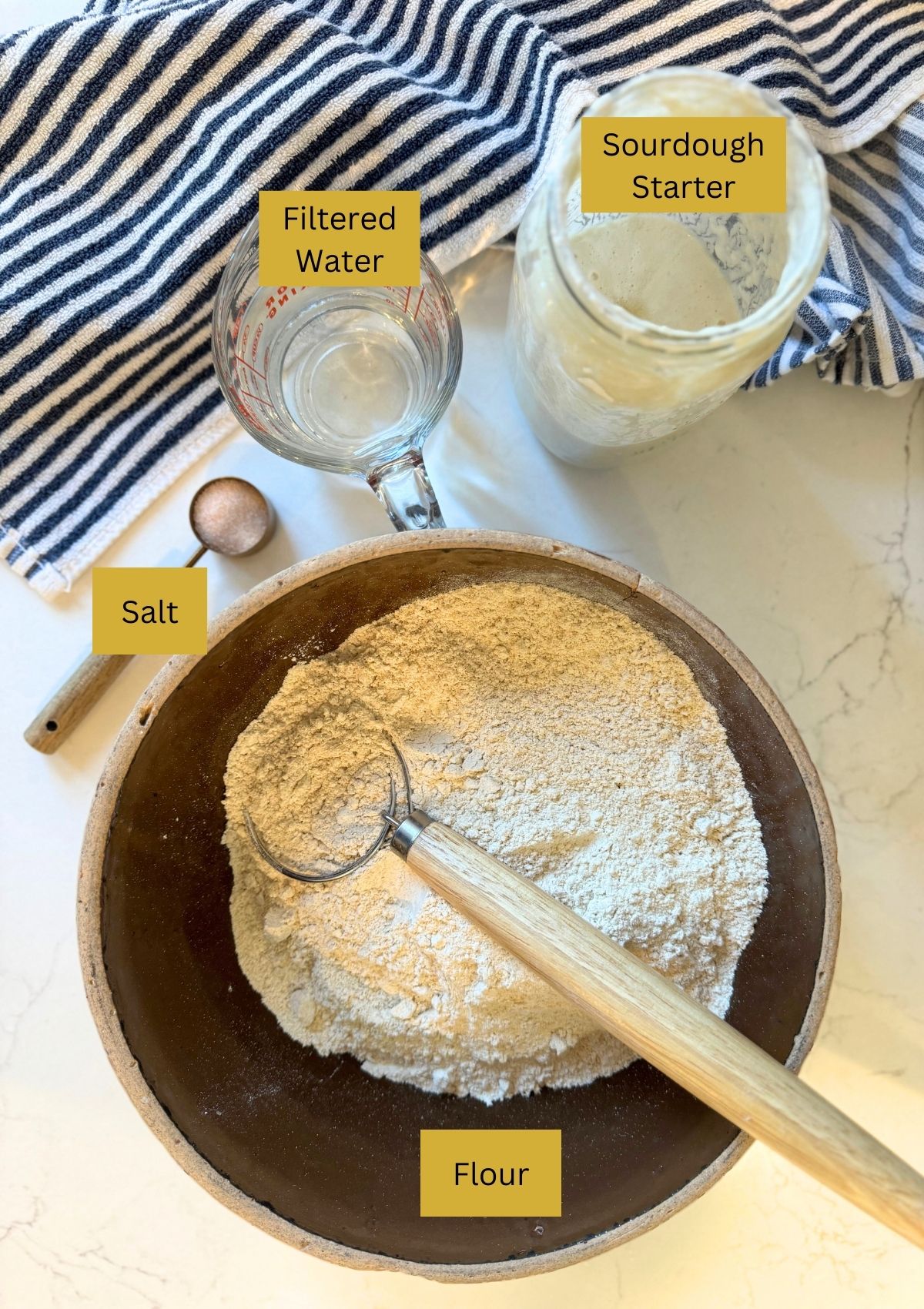
4 Basic Ingredients
Basic Tools
These tools make making sourdough bread easier and can help it to turn out fluffier and prettier. But you can most definitely make sourdough bread without some of them! Here are the tools I use:
- Large Mixing Bowl
- A Bench Scraper – to keep sticky dough off the counter and in your loaf.
- Dutch Oven – For best results use a Dutch oven with a lid. (Dutch ovens with lids hold in moisture while cooking bread causing the bread to rise more, or spring, better than cooking on a baking sheet or pan.)
- Parchment Paper – This is a luxury, not a necessity but I really love using it!
- Proofing Basket or Banneton or towel lined bowl – These baskets give your loaf those pretty circle designs around the loaf as it shapes into the basket over night.
- Tea Towel to Cover the rising dough with.
- A Wooden Spoon or Danish Whisk
- *Optional stand mixer with a dough hook. I just use my Danish whisk and hands.
- Razor or very sharp thin knife for scoring.
- Many sourdough bread recipes require you to use a kitchen scale, I do not use one for this recipe, and it turns out great every time… But I’m including weight measurements in the recipe card if you want to;)
Start a Sourdough Starter
If you are interested in making your own homemade starter, I share with you how to make sourdough starter from scratch!
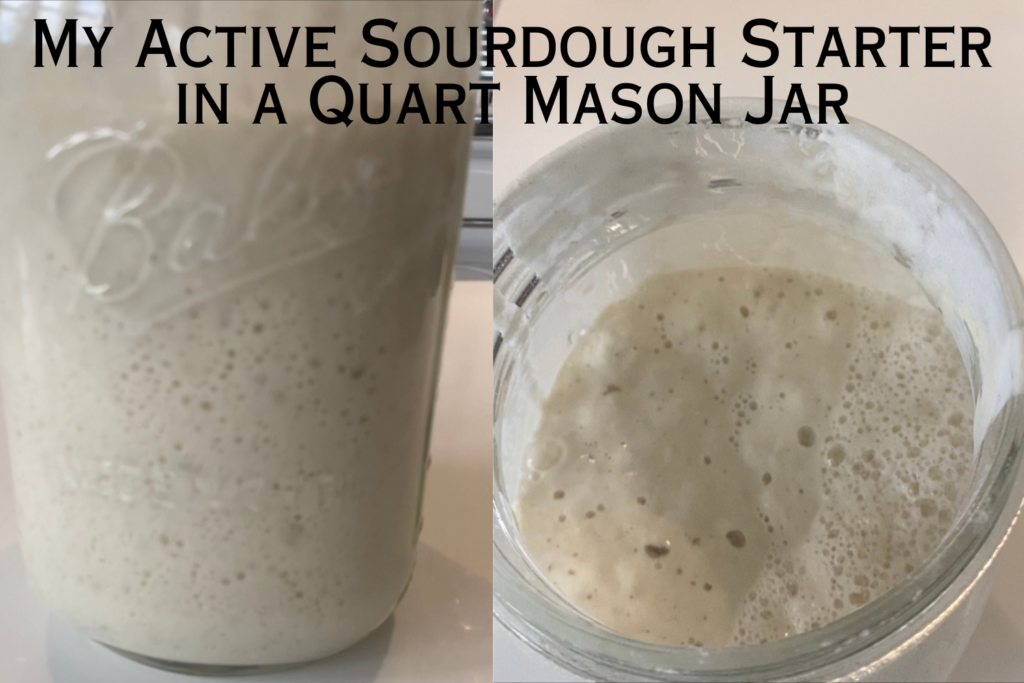
How to Use Sourdough Starter For This Recipe
Take the Starter out of the Fridge: If your sourdough starter has been refrigerated, take it out and let it come to room temperature for a few hours. It’s best to use a well-fed and active starter for baking.
Before using the starter, it’s a good practice to feed it to ensure it’s active and strong. Add equal parts of water and flour to your starter. Learn more about activating your starter here.
The amount of starter you need is 2 cups of sourdough starter, or 400 grams, for this recipe. You can use a kitchen scale to measure by weight, which is more accurate, or use measuring cups. I use 3/4 cup all purpose or bread flour (100 grams) and 2/3 cup (100 grams) filtered water for this recipe. And you’ll need 2/3-3/4 cup active starter (100 grams). This should get you 2 cups of active bubbly starter at the right hydration so that the bread dough isn’t too sticky.
Once your starter is active, you can incorporate it into your sourdough recipe. Follow the steps in this sourdough recipe for mixing, bulk fermentation, shaping, proofing, and baking.
After using the portion of starter for your bread, don’t forget to feed and maintain the remaining starter. If you’re not baking frequently, you can return it to the refrigerator and feed it regularly (weekly or bi-weekly) to keep it active;)
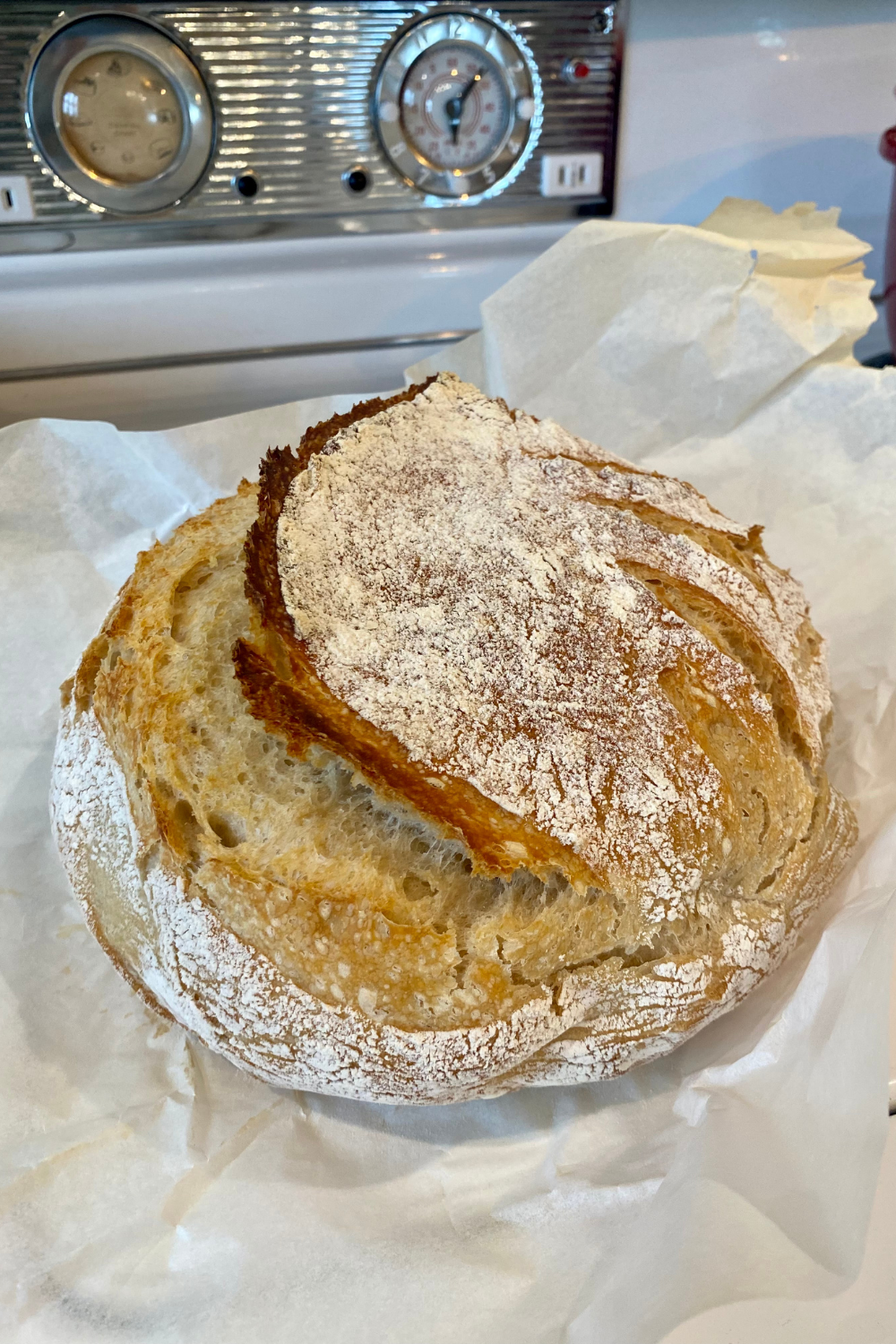
Instructions
- In a large mixing bowl (not metal) add “Levain”: 2 cups of 100% hydration active sourdough starter. To make the “Levain” add 3/4 cup all purpose or bread flour (100 grams) and 2/3 cup (100 grams) filtered water with 2/3-3/4 cup active starter (100 grams). Let this sit on the counter till doubled in size. This will yield 2 cups of active bubbly starter to use in the recipe. If you just use your starter without mixing it this way, the bread may be too sticky.
- Add 3 cups of sifted bread flour, or 360 grams. (Sift or fluff your flour before measuring so it isn’t too compact in the measuring cup.)
- Add 1 cup of warm water
- Add 1.5 teaspoons salt. (I use the Himalayan Pink Salt, use your favorite!)
- Use a large spoon to mix the ingredients together. It will be wet, shaggy dough.
- Cover this shaggy dough with a clean damp kitchen towel, and let the dough rest in a warm place for 2 hours. (Or in a warm oven (about 80 degrees) for about 1 hour)
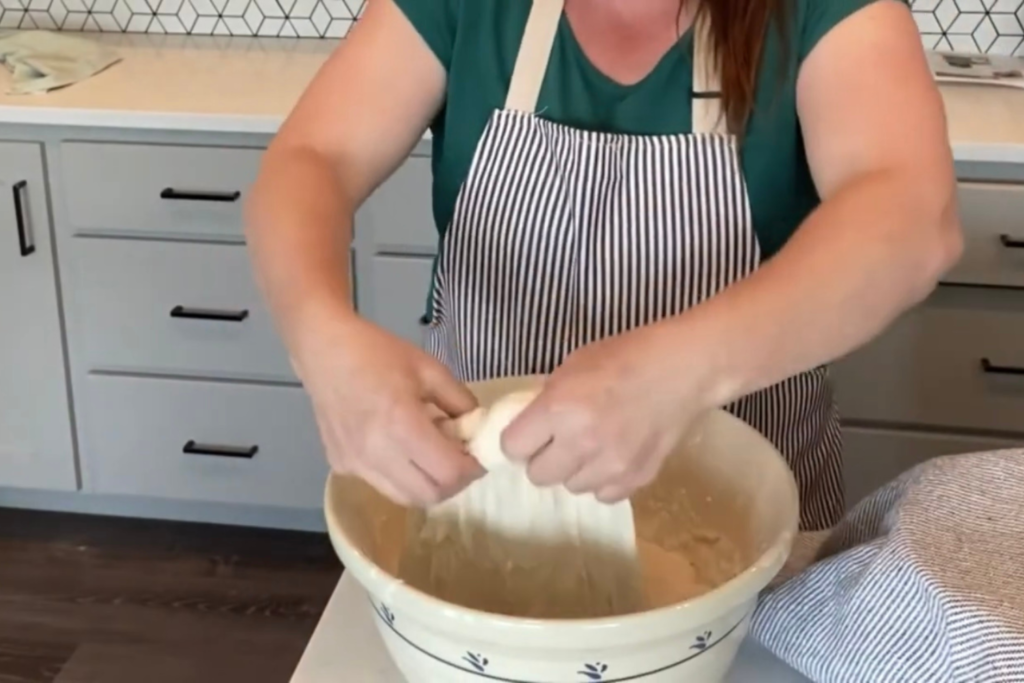

Stretch & Folds
First stretch and fold: After 2 hours of rising on your counter, uncover the dough, with wet hands pick up one side of the dough and fold it in half, over on top of the other side of the dough. Turn the bowl 90 degrees. Repeat 4-6 times by stretching and folding over all four sides of the dough, then rotating the bowl and repeating the stretch and folds on all sides. (The dough does not stick to wet hands as badly as dry hands.)
Rise: Cover with a clean towel (or plastic wrap), and let the dough rise (about 45 minutes depending on the temperature of your kitchen) or till doubled again.
Second stretch & fold: Uncover the dough, wet your hands, then pick up one side of the dough and fold it in half, over on top of the other side of the dough. Rotate bowl 90 degrees. Repeat 4-6 times by stretching and folding over all four sides of the dough. The dough is becoming more bread-like now!
Rise: Cover with a clean towel, and let rise till doubled again.
3rd stretch and fold: Uncover the dough, wet your hands, then pick up one side of the dough and fold it in half, over on top of the other side of the dough. Rotate the dough 90 degrees. Repeat 4-6 times by stretching and folding over all four sides of the dough. The dough is even more smooth and bread-like now!
Rise: Cover with a clean towel, and let rise till doubled again.
4th stretch and fold: Uncover the dough, wet your hands, then pick up one side of the dough and fold it in half, over on top of the other side of the dough. Turn the dough 90 degrees. Repeat stretch and folds 4-6 times by stretching and folding over all four sides of the dough, rotating the dough and doing it on all 4 sides each time. The dough is fluffy and bread-like now!
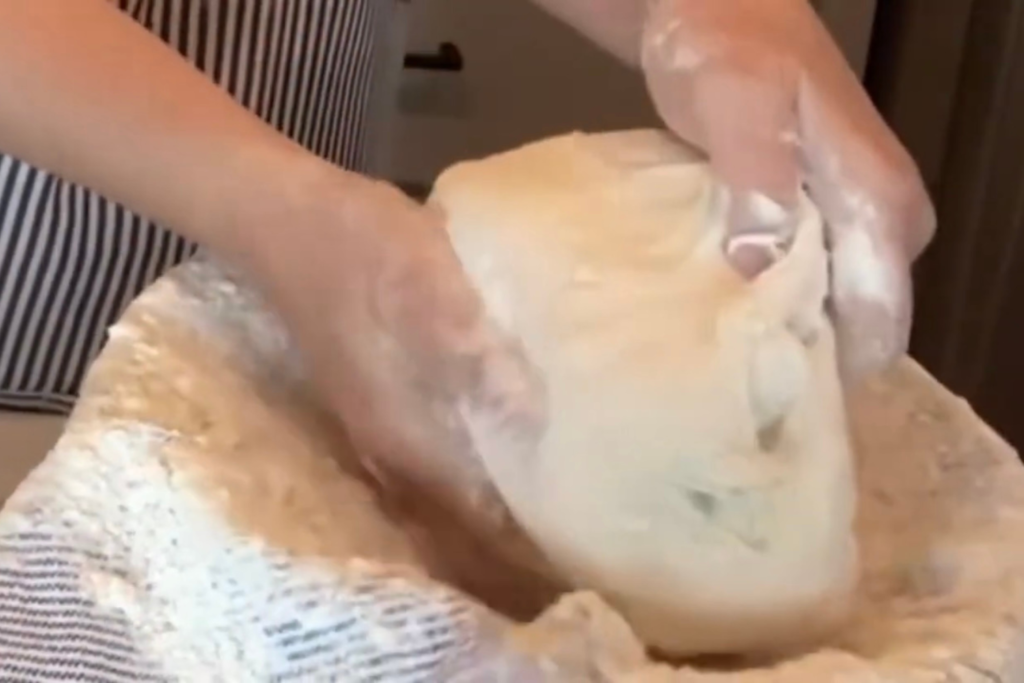
Shape your dough into a round loaf.
- Dust a towel, or proofing basket, generously with flour and put it into a large round bowl to rise one last time.
- Turn bread dough out onto a lightly floured work surface,
- Final Shape- Shape dough into a round loaf by pushing it back and forth to build surface tension on your loaf.
- Using a bench scraper, Place the dough ball into the floured towel in the large bowl, or into a floured banneton basket.
- Dust the top of dough ball generously with flour.
- Cover with a towel by folding over the ends (or use another clean towel.)
- Place the bowl into the refrigerator to chill and rise overnight, as bulk fermentation and final rise. (Now you can rest and pick up where you left of the next day!)
Day 2 – Baking Sourdough Bread
The next morning, when you are ready to bake, preheat your oven to 400 degrees F. and place your dutch oven into the oven to preheat too.
Cut a 2-foot section of parchment and place it on your counter.
Gently dump your chilled bread dough ball onto a large piece of parchment paper.
Lightly dust the top with flour, and spread it evenly over top with your hand, being careful not to push the dough down.
Scoring Sourdough Bread
Using a very sharp knife or razor blade, score a design into the top of your dough.
Score the top of the dough with your razor blade. Make your own design or use mine. This gives the loaf a constructive place to rise without bursting open during the baking process.
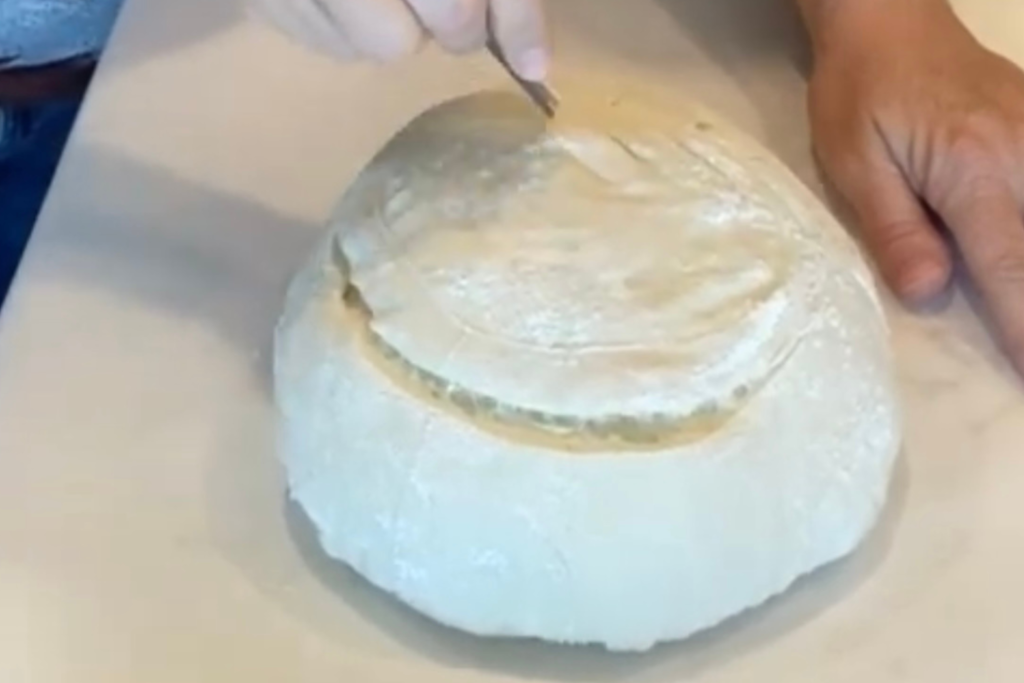
Remove your hot dutch oven from your preheated hot oven.
Lift your dough loaf into the Dutch oven by the ends of the parchment paper. (It’s ok for parchment paper to hang over the sides of the Dutch oven, it won’t burn.)
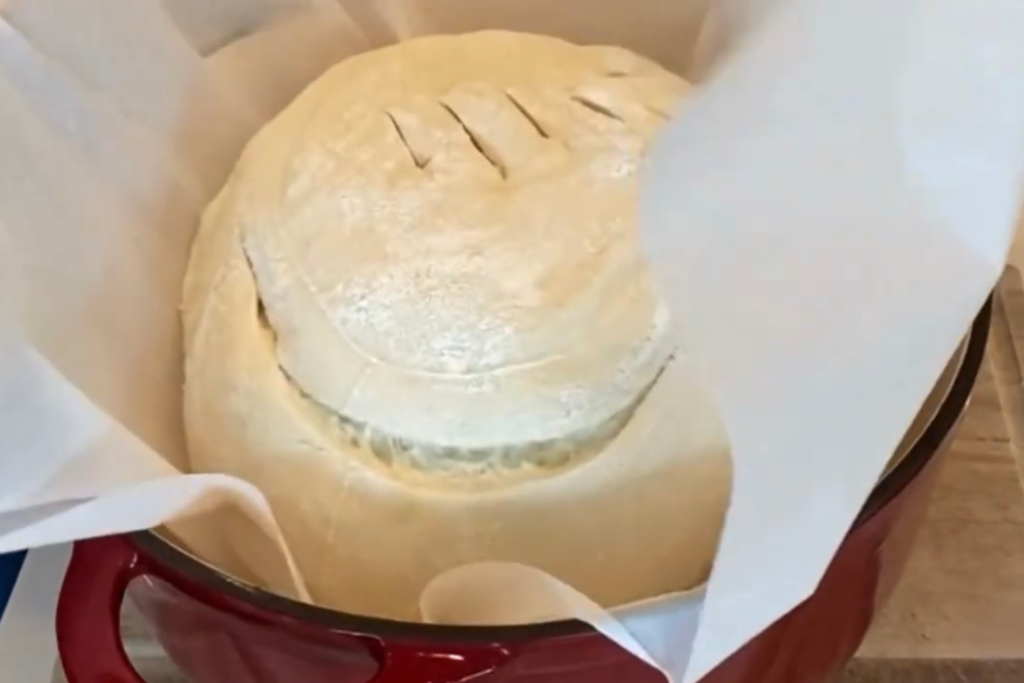
- Place the lid on your Dutch oven.
- Use hot pads or towels to put the hot Dutch oven back into the preheated oven at 400 degrees.
- Bake covered for 25 minutes.
- Then, Remove the Dutch oven lid.
- Bake for 25 more minutes! Your loaf should be nice and golden brown on top by now!
- Remove and place on a safe surface. (I like to use a cutting board or my stove top.)
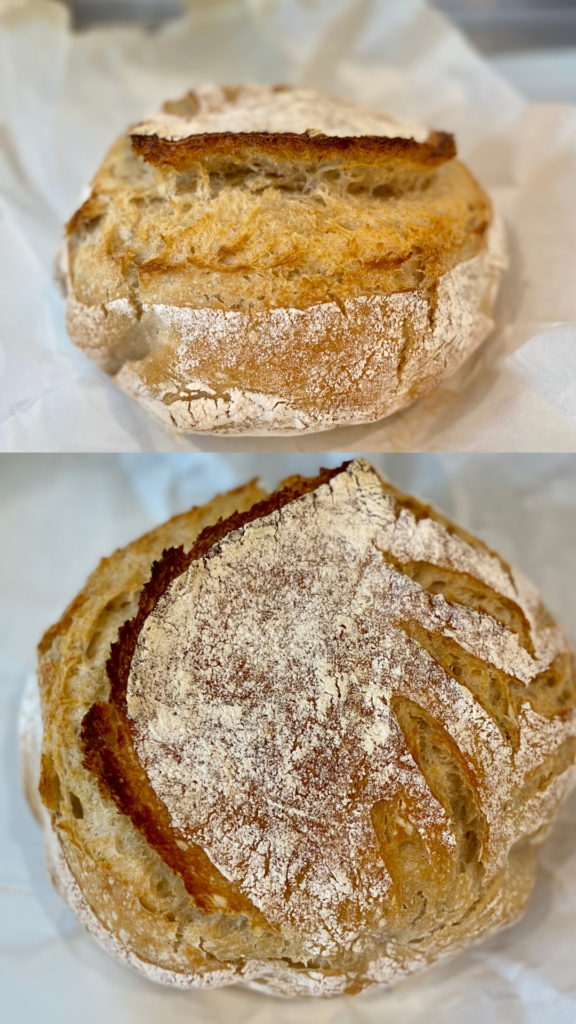
Place your sourdough bread on a cooling rack and cool completely to see all the beautiful air holes! If you cut into your loaf of bread right away the bread will be too soft to hold its form with all the beautiful air holes. It will taste amazing but doesn’t look quite as wonderful. Enjoy!
Dough Temperature
The speed at which sourdough dough rises depends on its temperature or the temperature of your kitchen for rising. For best results your sourdough ferments between the temperatures of 80–90°F (27–32°C). That temperature is optimal for the home bakers sourdough to rise. However, you can also get a faster rise with warmer temperatures, and of course, a slower rise in the fridge overnight with cooler temps.
My pilot light keeps my oven at 93 degrees all the time. At 93 degrees F, I can rise my sourdough dough in 1.5 hours to double. Then I stretch and fold, cover, and repeat the process 4 times before doing the final shape and refrigerating overnight.

RISING TIME & ROOM TEMPERATURE
The room temperature of your kitchen, or your rising space, makes all the difference in how long it takes to proof sourdough bread dough! In a cold kitchen (or rising spot) your dough will take all day to proof. I let my dough rise in a warm oven.
My oven has a pilot light which keeps it nice and warm, but not hot, at 93 degrees F. If you do not have a pilot light, preheat your oven to 180 degrees for about 5 minutes then turn it off. A great way to test the temperature of your oven is with an instant-read meat thermometer.
How to Store Leftovers
If you are lucky enough to have leftovers, place your homemade bread into an air-tight container or zip-lock bag, and store it on the counter for up to 4 days. If you store in the fridge the bread will get firmer, and not be as soft, but it softens up right away if you reheat it! (I think the best way to reheat sourdough bread is to pan-toast it with butter for breakfast!)
Leftover sourdough bread is also great to make croutons, the best French toast, bread pudding, or hot and cold and sandwiches!
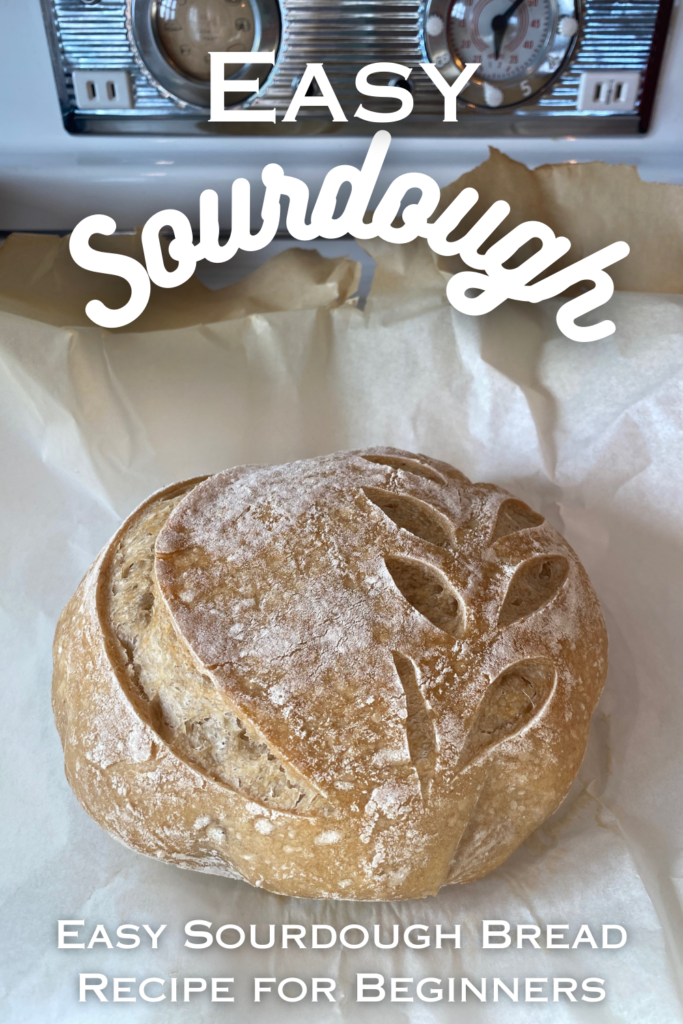
Tips for Success
- Good-quality flour and filtered, or unchlorinated, water are essential for a flavorful and successful sourdough bread. Chlorine in your water damages the probiotic sourdough and can make it less effective. Bread flour has more gluten and rises better. Whole-grain flours can add depth to the flavor.
- Fermentation is temperature-sensitive. If your kitchen is cold, consider placing the dough in a slightly warmer environment, like a turned-off oven with the light on, to facilitate the fermentation process.
- Autolyse: I don’t do this in this recipe, because it always works well for me the way it’s written. But you CAN autolyse your flour with water before adding the other ingredients to improve it. To autolyse: Mix your flour and water in a large bowl first, to hydrate together for 30 minutes to an hour, then add the the starter and salt. This helps improve the dough’s extensibility & structure.
- Longer fermentation times at lower temperatures (bulk fermentation) help develop a more complex flavor. Be patient and let the dough ferment at room temperature or in the fridge for the suggested time.
- During bulk fermentation, use the stretch and fold technique (gently stretching and folding the dough over itself) every 30-60 minutes for the first 2 hours. This enhances gluten development.
- Use a well-floured banneton or a cloth-lined bowl for the final proofing. It prevents sticking and shapes the dough beautifully.
- Preheat your oven and baking vessel (Dutch oven or combo cooker) for at least 20 minutes before baking to ensure a hot baking environment.
- Allow the bread to cool completely on a wire rack before slicing. Cutting into the bread while it’s still warm can result in a gummy texture.
Variations
You can make several variations of this sourdough recipe with different kinds of flour like whole wheat flour, all-purpose Einkorn flour, spelt flour, rice flour in combination with gluten-free flours, organic flour, and other kinds of whole grain flour.
Adjust the amount of flour that you use if changing from all-purpose, especially if you are using fresh ground grains. It should be 360 grams of flour.
Try this recipe for Jalapeno Cheddar Sourdough bread or with chopped dates for sweet date sourdough bread.
You can also add 1/2 cup of cocoa to your dough before mixing for a chocolate sourdough loaf. This sourdough bread can also be cooked a regular bread pan for soft sourdough sandwich bread.

More Sourdough Recipes
- Enriched sourdough for Soft Sourdough Rolls. Easy pull apart dinner roll recipe.
- Sourdough cheddar biscuits. – Quick recipe for a last-minute side dish that everyone loves!
- Sourdough Pumpkin Bread – Perfectly spiced pumpkin bread with sourdough. A great snack or breakfast!
- Sourdough English Muffins – Super simple English muffin recipe for egg sandwiches for toast!
Let me know what YOU think about this recipe!
If you try this recipe, I’d love if you give it a review on the recipe card, and let me know how it turned out in the comments or review! Tag me on Instagram @farmhouse_harvest with your delicious creation!

No Knead Sourdough Bread Recipe (with video)
Ingredients
- 2 cups 100% hydration sourdough starter made from equal parts flour and water (or 552 grams)
- 3 cups sifted all purpose flour or 360 grams
- 1 cup warm water or 240 grams
- 1.5 teaspoons salt or 8.535 grams
Instructions
- In a large mixing bowl (not metal) add 2 cups 100% hydration active sourdough starter. (For active starter, feed it and keep it OUT of the fridge for at least 4 hours, or overnight.)
- Add 1 cup warm water and whisk till well combined with the starter.
- Add: 3 cups sifted flour. (Sift or fluff your flour before measuring so it isn’t too compact in the measuring cup.) And 1.5 teaspoons salt. (I love to use Himalayan Pink Salt)
- Use a large spoon to mix ingredients together. It will be wet, biscuit-like dough.
- Cover the dough in the bowl with a wet clean towel, and let it rest for 2 hours in a warm spot.
- 1st stretch and fold: Uncover dough, wet your hands then pick up one side of the dough and fold it in half, over on top of the other side of the dough. Repeat 4 times by stretching and folding over all four sides of the dough.
- Rise: Cover with a clean towel, and let rise till doubled again.
- 2ne stretch & fold: Uncover dough, wet your hands, then pick up one side of the dough and fold it in half, over on top of the other side of the dough. Repeat 4 times by stretching and folding over all four sides of the dough. The dough is becoming more bread-like now!
- Rise: Cover with a clean towel, and let rise till doubled again.
- 3rd stretch and fold: Uncover dough, wet your hands, then pick up one side of the dough and fold it in half, over on top of the other side of the dough. Repeat 4 times by stretching and folding over all four sides of the dough. The dough is even more bread-like now!
- Rise: Cover with a clean towel, and let rise till doubled again.
- 4th stretch and fold: Uncover dough, wet your hands, then pick up one side of the dough and fold it in half, over on top of the other side of the dough. Repeat 4 times by stretching and folding over all four sides of the dough.
- After 4th stretch and fold, SHAPE YOUR DOUGH INTO A ROUND LOAF.
- Dust a towel, or proofing basket, generously with flour. And place shaped sourdough bread dough ball in it.
- Dust top of dough ball with flour, and cover the top with a clean towel.
- Refrigerate: Place the sourdough bread bowl into the refrigerator to chill and rise overnight.
- Preheat Oven, the next day when you are ready to bake, preheat your oven to 400 degrees F. and place your dutch oven into the oven to preheat too.
- Parchment paper: Cut a 2-foot section of parchment and place it on your counter.
- Gently turn out your chilled sourdough ball onto the parchment paper.
- Score: USE A VERY SHARP KNIFE OR RAZOR to SCORE A DESIGN INTO THE TOP OF YOUR DOUGH.
- Remove the hot dutch oven from your preheated oven.
- Place dough into the dutch oven: Lift the raw sourdough loaf into the dutch oven by the ends of the parchment paper. (It’s ok for parchment paper to hang over the sides of the dutch oven.) And put the lid on your dutch oven.
- Bake: Use hot pads or towels to put the hot dutch oven back into the preheated oven at 400 degrees. Bake covered for 25 minutes.
- Remove the dutch oven lid.
- Bake for 25 more minutes!
- Let cool and enjoy!
- Ask me any questions you have in the comments. And don't forget to rate this recipe card and let me know what you think!
Video
Notes
Nutrition

About Juliea
Juliea Huffaker is the creator of Farmhouse Harvest, and dedicated to teaching from-scratch cooking, sourdough baking, gardening, and food preservation. With over 25 years of hands-on experience she has preserved hundreds of jars of produce, mastered the art of meats and sourdough baking, and nurtured a thriving organic garden. Her recipes and articles have been featured across the web. And she’s passionate about inspiring others to embrace a simpler, self-sufficient life style.











36 comments
Tamara A.
Wow! This is the first time I have been able to successfully make sourdough bread. This step-by-step recipe is awesome. I’m making another loaf today!
Juliea Huffaker
That’s the best compliment.. So glad you enjoy it as much as I do!
Juliea Huffaker
Hi Selina! How are you preparing your sourdough starter? It may be too wet to start with. See above “I use ¾ cup all purpose or bread flour (100 grams) and ⅔ cup (100 grams) filtered water for this recipe. And you’ll need ⅔-3/4 cup active starter (100 grams). This should get you 2 cups of active bubbly starter at the right hydration so that the bread dough isn’t too sticky.” If this isnt the reason you may be in a very humid climate, or the temperature may be very warm and it’s fermenting super fast?
Selina
How do I stop it from fermenting so fast then? Because I have a 1:1:1 starter by weight.
Juliea Huffaker
Don’t put it in a warm spot to bulk ferment between stretch and folds if it’s fermenting too fast… You can refrigerate to retard the fermentation process… Or if you have a cooler spot for the bulk ferment;)
Judith
I’ve tried enough sourdough recipes but I find so many of them are a little “extra” than I’d want. I’ve been looking for a simple, no-nonsense and delicious sourdough loaf recipe and this recipe is it.
Juliea Huffaker
It may be the starter… This is how I make my 2 cups of active starter (if it’s too wet the dough will be too sticky) FIRST PREP YOUR STARTER – LEVAIN
Early in the morning prep your starter by creating a batch of levain, the active portion of your sourdough starter, using a 1:1:1 ratio by weight with your established starter. This recipe will yield at least 2 cups (480 ml) of levain.
Ingredients:
– Existing sourdough starter (active and bubbly): 100 grams – ⅔ cup (120 grams) to ¾ cup (180 ml). The starter’s consistency can affect the amount in a cup. Err on the side of less starter at first… You can always add a bit more if the levain seems too dry after mixing;)
– All-purpose flour: 100 grams – ¾ cup (120 grams). This is a slightly rounded amount to account for the packing density of flour. Scooping flour can compress it, leading to less flour than intended. Sifting the flour can help get closer to 100 grams.
– Water: 100 grams – ⅔ cup (180 ml).
Measure your ingredients: If you don’t have a scale, discard any hooch from your starter and then scoop out what appears to be 100 grams. Weigh out 100 grams each of all-purpose flour and water.
Combine ingredients: In your clean glass jar, whisk together the starter, flour, and water until a thick batter forms. There should be no dry flour streaks.
Cover and store: Loosely cover the jar with a lid or cloth to allow some airflow. Store your levain at room temperature (around 70-78°F / 21-26°C).
Over the next few hours, your levain should become quite active, showing significant bubbles and roughly doubling in size. This typically takes 4-8 hours, depending on your starter’s health and temperature.
Target Levain Ripeness: Ideally, your levain should be at its peak ripeness when it reaches its maximum volume and starts to show signs of doming or collapsing slightly in the center. This indicates the levain has used most of the available sugars and is ready to contribute leavening power to your dough. It should double or triple in height!
Juliea Huffaker
Hi Julie! You can rise and bake after the 4th stretch and fold! It’s just not as fermented… But I’ve done that and it’s still wonderful sourdough bread!
Juliea Huffaker
Hi Alexis.. Just measure out the active starter for the recipe… Then add equal parts flour and water to your starter jar. With just a bit of leftover starter on the jar it will be enough to make a new batch;)
Darin
Crusty outside and chewy inside. This sourdough bread is so good!
Darin
Delicious sourdough bread! I love when my wife makes this recipe!
Juliea Huffaker
Hi Pat! No.. This does not replace the stretch and folds… Some people like to mix the individual ingredients together the first time with an electric mixer and dough hook… I do not. I just stir together till combined with a rubber spatula;)
Juliea Huffaker
Hi Lauren! The rising time really depends on the temperature of your home, or rising spot. I give it an hour or two before the first stretch and folds, then 30-45 minutes till it has risen again, then my second stretch and folds, and repeat letting it rise 30-45 minutes between or till you can see that it has risen well 😉
Juliea Huffaker
Hi Rebecca.. That’s awesome that your oven has a proofing function! Yes you can speed up the process by putting it in the warm oven (assuming its about 80-90 degrees?) Just keep an eye on it as you’ll do stretch and folds closer together;) That should cut down on your proofing time a lot!
Juliea Huffaker
Yea… I’m so glad you love this recipe Rose! Yes I’d bake for 15-20 minutes with and then 15-20 minutes without the lid… Till Golden, but not brown.
Juliea Huffaker
Hi Barbara! I always flour my towel or banneton basket liner really well before the final shaping and refrigerating over night. Sounds like it stuck to the towel, because it didn’t have enough flour on it. Or, it stayed in the fridge too long and over fermented? These are just guesses… This recipe ferments faster than most because it has more starter in it, so I always back my sourdough bread early the next day;)
London Goodnight
Baked a loaf today and it’s great!
What are is the nutritional value?
Juliea Huffaker
Hi London… Yea! So glad it turned out great! I’m adding the nutritional value to the recipe card now!
Juliea Huffaker
For 10 servings it’s 2223 calories. 7 grams protein, 47 carbs, 3 grams fiber…. My family eats about a 10th of the loaf each… But you can break it down from there for more servings! Hope this helps!
Juliea Huffaker
Hi Lori! This recipe calls for a lot more starter than most… But it turns out delicious and beautiful. It adds extra moisture making it a higher hydration loaf, but more of the flour in the recipe is pre-fermented, so it ferments f aster too. It’s 2 cups of active starter…. I weighed it to get an exact amount for those who want it. But usually I just measure out 2 cups of active starter;)
darin
we love this recipe and make it weekly
Maddy
My dough doesn’t look like it’s rising or not at least that I can tell. How do you know if it’s risen correctly?
Juliea Huffaker
If your bread is rising you will see that it has grown or doubled in size… But sourdough takes a lot longer than commercial yeast to rise. It can take 4 hours for your dough to double in size at room temperature;)
Olivia Hardin
Is the dough supposed to change?? I don’t see mine really doubling in size after each fold and it’s pretty jiggly and sticky still
Juliea Huffaker
Hello Olivia! Your dough will be rising slowly. If it’s too sticky, just run your hands under cold water and then do stretch and folds… this helps the dough not to stick to your hands. Let your dough rise between stretch and folds. The gluten develops during the rising and stretch and folds and makes it a beautiful dough. If you let it rise in a warm place it helps speed up the process! I hope this answers your questions… If you have more, don’t hesitate to ask!
Meagan
This was my first attempt at sourdough bread. Even though I realized a few things I should have done a little differently, I still came out with an amazing result! Thank you for the extra details. It really helps beginners like me!
Darling
This sourdough bread recipe is different from most as it uses more starter…. But it can be made all in one day as it ferments faster! The crumb is perfect, and we love it!
Jane Fagan
I have a couple , three or four questions regarding your sour dough starter.
I mixed up the flour & potatowater on Monday On Tuesday it looked like it was doing good on Tuesday I added more flour & potato water, mixed it a couple times thar day. Your instructions did nt tell me to discard ant. On Wed, the flour & water separated but you could see where it rose then fell . I continued following your instructuns.. This morning it was worse. It did not rise & fall . Am I suppose to be discarding 3/4 of the flour mixture daily?
juliea
Hi Jane! Yes you do need to discard down to the original measurements (I use 2 cups, you can also use 2 tablespoons) while making the starter…otherwise you’ll have to feed it too much everyday.
Janet Catacutan
I was able to find good information to start my sourdough from your articles.
kelly
I’m finding that after about 4 days of adding flour and water, when I added flour and water it just kind of goes flat….I didn’t add flour and water one day, and now it’s good and bubbly again? Is it ready to use? It’s been 6 days today…and I just yesterday was first day I quite adding water and flour. IS it ready to go? And, just so I’m interpreting the bread making right…the 50% hyrdrated starter is hydrated because i put it in the fridge for 4 hours to overnight? Also, on the stretch and folds…is it four times per all four sides or four times total? Just don’t want to overdo it 🙂
juliea
Hi Kelly! Yes if your starter is bubbly it’s good to use! I just stretch and fold 4 times. Then let it rise again and repeat.
50% hydration on the starter just means your starter is half water and half flour.
Julia
Wow! This is so comprehensive. Thank you for sharing all of these details. I wonder if I can do something like this with glueten free flour?
juliea
Hi Julia! Thanks for your comment! I’m not sure that gluten free flour would hold together as well. It would probably work but be a little less chewy inside, and might not rise as much with a gluten free flour. Let me know how it goes, I’d love to know!
Dani
Can’t wait to try this recipe!
juliea
Thanks Dani! It’s super easy, and delicious! Enjoy!